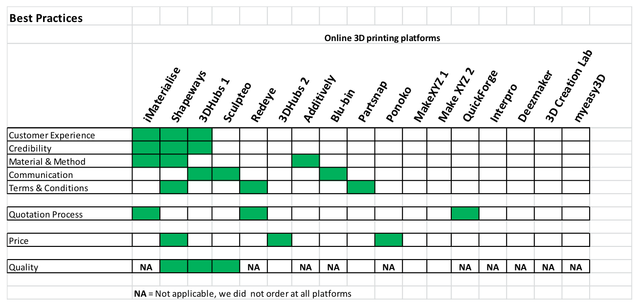
You can order almost anything you want online, thanks to social media and e-commerce.
Consumers expect to compare prices, quickly and easily, whether on a mobile or laptop. Customers want to place an order, pay and wait for it to arrive.
Online shopping should be that simple. A few clicks should be all it takes.
Except when it comes to ordering from the majority of 3D printing platforms.
That’s the verdict from Berenschot consultants, a tech-focused consultancy, one that has been active in 3D printing industry for over ten years.
Berenschot tried an experiment in 2014, to see how easy it is to order ABS Clips (designed to hold up presentation paper on a clipboard) through fifteen 3D printing platforms. All they wanted was to order 30 decent quality clips, for a reasonable price, with the same ease they would order anything else online.
Anything But Simple
The consultants at Berenschot conducting this experiment were evaluating these 15 platforms within the following criteria:
- The overall experience
- The way the platform demonstrates credibility
- Information on materials offered and printing method used
- The terms & conditions
- The ease of the ordering process.
- The results were disappointing: “It is fair to say that in real life we would have abandoned the process in eight of the fifteen cases.”
The following problems were encountered:
- Slow response times for quotes (when they wrote this article they were still waiting on three quotes, weeks after making an initial enquiry);
- Wide variation in price and quantity (from €8.47 and €165.00);
- A shockingly high, 66.666% failure rate, since they could only order from five of 15 platforms;
- They ordered 30 clips per platform, but only received 37 in total (missing 113 from the 150 ordered);
- A high failure rate once the printed ABS clips were received: Some were dead on arrival. Others failed in practice. The most expensive weren’t the ones that worked most effectively.
If the average consumer encountered these same issues on Amazon or eBay, they would soon be out of business.
After this test, Berenschot recommends 3D printing firm’s start to consider the following more seriously:
- Clarity of Message and Service offering. Make sure that customers know what they can expect by providing them with a sitemap, options, clear description of the ordering process, terms and conditions.
- Guidance and advice on different file formats and materials that are offered will help consumers to choose which of these fit their design best. Allow customers to have a closer look at the printing process increase credibility and their confidence in what is being offered.
- Personal attention and customer service. Provide guidance, an FAQ section and quick response to questions. Give them the ability to get a quote and pay as quickly as possible.
- Professionalism. It seems so simple: paying attention to accuracy in spelling, grammar, a user-friendly web experience and customer positive reviews; all increase confidence for customers.
The industry has the potential to change the nature of manufacturing. But, only if we spend more time delivering great service every time.
Customers want service; they want a simple ordering process and products delivered at a high quality for a good price. Otherwise, they will give up on 3D printing altogether.

Constantine Ivanov, Co-Founder & CEO of DigiFabster: A CRM fit for 3D Printing Industry. Streamline 3D Printing Orders & Customer Relations Management.

